Ocean to Ocean Automobile Endurance Contest
The Ocean to Ocean Automobile Endurance Contest was a transcontinental automobile race held in 1909. The race began in New York City on June 1, 1909 and the first car reached Seattle on June 23. The race was held in conjunction with the Alaska–Yukon–Pacific Exposition, a world's fair held in Seattle, and both events began on the same day.[1]
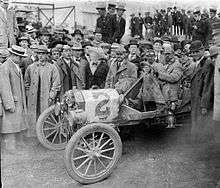
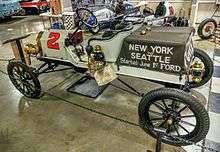
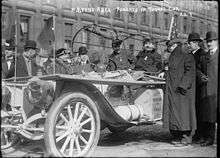
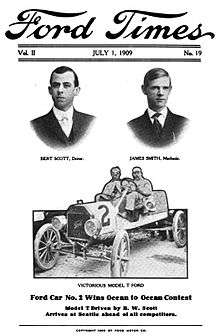
Background
The race was co-sponsored by the Automobile Club of America, the Seattle Automobile Club, the Alaska–Yukon–Pacific Exposition and Henry Ford.[1]The prize money and the trophy were donated by M. Robert Guggenheim.[2] The first place prize was $2000.00 and the second prize was $1500.00.[1]
The route was surveyed in advance by a designated pioneer car, a Thomas Flyer that had won the 1908 New York to Paris Race. It took two months for the Thomas car to establish a practical route, emphasizing the poor condition of roads at that time.[1]
East of the Mississippi River, the race was an endurance run. The cars could operate only during daylight hours and had to observe local speed limits. West of the Mississippi, where roads were more primitive, the competitors had no limits on either speed or hours of operation.[1]
The race
In the publicity before the race began, Henry Ford predicted that it would "give Americans an opportunity to appreciate the vast possibilities of the motor car".[3]
At the beginning of the race, commentators observed that the two light weight Model Ts seemed like "pygmies" compared to their heavier and more powerful competitors. As the race proceeded, the advantages of the Model T became apparent. Although smaller, it had a superior weight to power ratio. In addition, the Ford Motor Company already had established dealers across the country who were prepared to offer prompt and professional repair services. Ford's strongest competitor, a more powerful Shawmut, lacked access to dealerships after the race cars left New York. [4]
The competitors encountered many obstacles. The Ford team reported running out of gas, fires, getting lost, axle deep mud, and quicksand.[5] The race leaders encountered heavy snow at the Snoqualmie Pass in the final days of the race, which was considered the most difficult part of the course.[5][1]
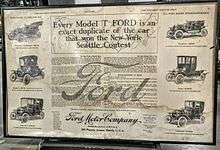
The race was covered by major newspapers such as the New York Times which reported details as the cars approached Seattle.[6]
Contested result
The Ford No. 2 car, a stripped down Model T, was the first to cross the finish line after 23 days on the road. This was the second year of Model T production, and Henry Ford immediately advertised the race results heavily, and the Model T went on to be the best selling car in the first half of the 20th century.
Five months later, the Ford No. 2 car was disqualified because it had an engine changed during the race, in violation of the rules. The second place Shawmut car was awarded the win, but that company went out of business while the Ford Motor Company thrived.
Centennial re-enactment
The race was re-enacted in 2009.[7] Fifty-five Model T Fords participated in the re-enactment, representing all 50 of the United States and five foreign countries.[7]
References
- "Automobile race". When The World Came to Campus, AYPE 1909. University Libraries - University of Washington. Retrieved September 13, 2016.
- "Auto Cup Donor Arrested: M. Robert Guggenheim Held for Exceeding the Speed Limit". New York Times. June 19, 1909. p. 3. Retrieved September 13, 2016.
- Reisler, Jim (2015). Walk of Ages: Edward Payson Weston's Extraordinary 1909 Trek Across America. University of Nebraska Press.
- Wells, Christopher W. (2013). Car Country: An Environmental History. University of Washington Press. ISBN 9780295804477.
- Nash, Lyman M. (September 1964). "Ford's Fabulous Flivver: The Model T was ugly as sin but it captured the imagination of America". Boys' Life. Boy Scouts of America. Retrieved September 13, 2016.
- "Ford No. 2 in the Lead: New York to Seattle Automobilists Reach Baker City". New York Times. June 21, 1909. p. 8. Retrieved September 13, 2016.
- Harrop, Joanne Klimovich (June 13, 2009). "Cross-country Model T trip is drive of lifetime". Pittsburgh Tribune-Review. Retrieved September 13, 2016.